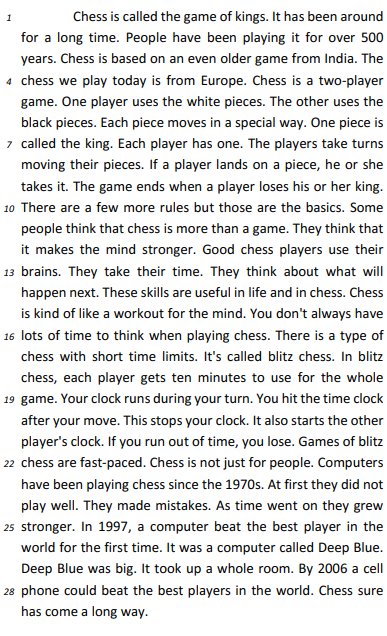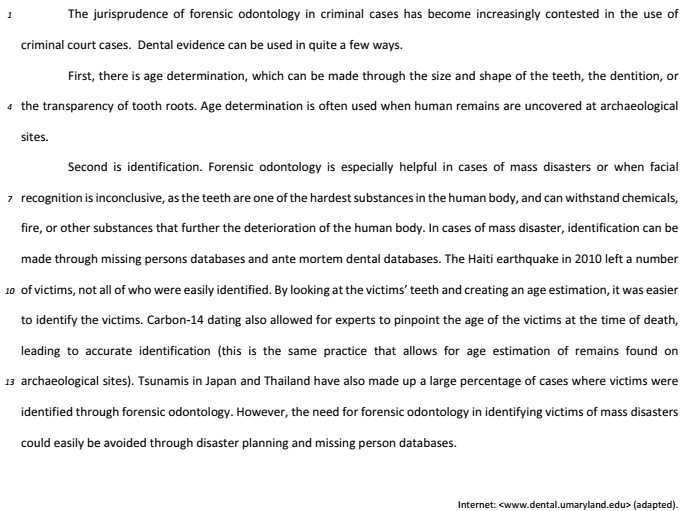Questões de Inglês - Adjetivos | Adjectives para Concurso
Foram encontradas 374 questões
1. As used in paragraph 3, the best synonym for ‘ascend’ is ‘climb’.
2. As used in paragraph 3, the best antonym for ‘descend’ is ‘fall’.
3. According to the author, wicker is “a pliable twig to make items such as furniture and baskets”.
4. The words ‘higher’ and ‘lower’, as used in the last paragraph are examples of the comparative of superiority form of the adjectives ‘high’ and ‘low’.
Choose the alternative which presents the correct sentences.
I. “Jennifer does chores ______ because she doesn’t trust others to do them right.” II. “This is the first time I’ve ______ this | seen him so angry | seen this | heard about it.” III. “The teacher asked _______ coat was on the floor but no one answered.” IV. “If I had ______ up earlier this morning, I wouldn’t have caught him red-handed.”
Education
Education encompasses both the teaching and learning of knowledge, proper conduct, and technical competency. It thus focuses on the cultivation of skills, trades or professions, as well as mental, moral & aesthetic development.
Formal education consists of systematic instruction, teaching and training by professional teachers. This consists of the application of pedagogy and the development of curricula.
The right to education is a fundamental human right. Since 1952, Article 2 of the first Protocol to the European Convention on Human Rights obliges all signatory parties to guarantee the right to education. At world level, the United Nations’ International Covenant on Economic, Social and Cultural Rights of 1966 guarantees this right under its Article 13.
Educational systems are established to provide education and training, often for children and the young. A curriculum defines what students should know, understand and be able to do as the result of education. A teaching profession delivers teaching which enables learning, and a system of policies, regulations, examinations, structures and funding enables teachers to teach to the best of their abilities.
Primary (or elementary) education consists of the first
years of formal, structured education. In general, primary education consists of six or seven years of schooling starting at the age of 5 or 6, although this varies
between, and sometimes within, countries. Globally,
around 70% of primary-age children are enrolled in
primary education, and this proportion is rising.
In most contemporary educational systems of the world, secondary education consists of the second years of formal education that occur during adolescence. It is characterized by transition from the typically compulsory, comprehensive primary education for minors, to the optional, selective tertiary, “post-secondary”, or “higher” education (e.g., university, vocational school) for adults.
Higher education, also called tertiary, third stage, or
post secondary education, is the non-compulsory
educational level that follows the completion of a
school providing a secondary education, such as a
high school or secondary school. Tertiary education is
normally taken to include undergraduate and postgraduate education, as well as vocational education and
training. Colleges and universities are the main institutions that provide tertiary education. Collectively,
these are sometimes known as tertiary institutions.
Tertiary education generally results in the receipt of
certificates, diplomas, or academic degrees.
’Globally, around 70% of primary-age children are enrolled in primary education, and this proportion is rising.’
the underlined words are, respectively:
Education
Education encompasses both the teaching and learning of knowledge, proper conduct, and technical competency. It thus focuses on the cultivation of skills, trades or professions, as well as mental, moral & aesthetic development.
Formal education consists of systematic instruction, teaching and training by professional teachers. This consists of the application of pedagogy and the development of curricula.
The right to education is a fundamental human right. Since 1952, Article 2 of the first Protocol to the European Convention on Human Rights obliges all signatory parties to guarantee the right to education. At world level, the United Nations’ International Covenant on Economic, Social and Cultural Rights of 1966 guarantees this right under its Article 13.
Educational systems are established to provide education and training, often for children and the young. A curriculum defines what students should know, understand and be able to do as the result of education. A teaching profession delivers teaching which enables learning, and a system of policies, regulations, examinations, structures and funding enables teachers to teach to the best of their abilities.
Primary (or elementary) education consists of the first
years of formal, structured education. In general, primary education consists of six or seven years of schooling starting at the age of 5 or 6, although this varies
between, and sometimes within, countries. Globally,
around 70% of primary-age children are enrolled in
primary education, and this proportion is rising.
In most contemporary educational systems of the world, secondary education consists of the second years of formal education that occur during adolescence. It is characterized by transition from the typically compulsory, comprehensive primary education for minors, to the optional, selective tertiary, “post-secondary”, or “higher” education (e.g., university, vocational school) for adults.
Higher education, also called tertiary, third stage, or
post secondary education, is the non-compulsory
educational level that follows the completion of a
school providing a secondary education, such as a
high school or secondary school. Tertiary education is
normally taken to include undergraduate and postgraduate education, as well as vocational education and
training. Colleges and universities are the main institutions that provide tertiary education. Collectively,
these are sometimes known as tertiary institutions.
Tertiary education generally results in the receipt of
certificates, diplomas, or academic degrees.

Internet: <www.nortechplus.com>.
Read the following text and answer question.
Importance of Aquaculture
Aquaculture involves the art, science and business of breeding aquatic animals and plants in fresh or
marine waters for human use. It also extends to the marketing of such organisms in a controlled environment. It is a kind of agriculture, and therefore, it requires inputs such as clean water and nutrients.
It also requires storage for harvested produce, transportation and marketing facilities.
Inputs often depend on the species that are farmed. Species lower on the aquatic food chain usually require less input, as they feed on microorganisms and are fine in just clean water. More inputs like fish or fishmeal, cereals, or grains are required, as we get higher on the food chain with species like salmon or tuna.
All over the world, the demand for seafood has increased because people have learned that seafood as part of regular diets are healthier and help fight cardiovascular disease, cancer, Alzheimer’s and many other major illnesses.
Aquaculture will add to wild seafood, and make it _______ and accessible to all.
Aquaculture business provides tax and royalty revenue to local governments. Besides, there is also potential revenue from exports.
(Adapted from: https://goo.gl/qcbcfY. Access: 01/25/2018)
Read the following text and answer question.
Importance of Aquaculture
Aquaculture involves the art, science and business of breeding aquatic animals and plants in fresh or
marine waters for human use. It also extends to the marketing of such organisms in a controlled environment. It is a kind of agriculture, and therefore, it requires inputs such as clean water and nutrients.
It also requires storage for harvested produce, transportation and marketing facilities.
Inputs often depend on the species that are farmed. Species lower on the aquatic food chain usually require less input, as they feed on microorganisms and are fine in just clean water. More inputs like fish or fishmeal, cereals, or grains are required, as we get higher on the food chain with species like salmon or tuna.
All over the world, the demand for seafood has increased because people have learned that seafood as part of regular diets are healthier and help fight cardiovascular disease, cancer, Alzheimer’s and many other major illnesses.
Aquaculture will add to wild seafood, and make it _______ and accessible to all.
Aquaculture business provides tax and royalty revenue to local governments. Besides, there is also potential revenue from exports.
(Adapted from: https://goo.gl/qcbcfY. Access: 01/25/2018)
Read the following text and answer question.
Introduction to global food loss and food waste
Food losses and food waste are quickly becoming a top global issue, because while there are millions of families with children starving, others are living in abundance, with many others carelessly throwing food away. Many of us have wasted food in one way or the other, but the real food losses and waste matter is ______ than just consumer food waste.
From farming fields and storage places, through transportation, processing, market places, down to
consumption places such as homes, schools, restaurants and workplaces, more than half of all food
produced globally go to waste. This is a tragedy!
In developing countries, it takes a lot of man-power to produce food. In more advanced countries, machines and technology are used, but the drain on energy, destruction of vegetative lands, the use of chemicals and ______ impact on the environment are phenomenal. Putting all that together, it is clear that a major problem has emerged and we are all in a position to help in one way or the other.
(Adapted from: https://goo.gl/ySEn3F. Access: 01/23/2018)

In line 7, “broad-leaved” is not an adjective.

In the first paragraph, “exacerbated” and “overwhelmed” are both adjectives and refer to how the author feels about people being so busy.
According to the text, judge the item.
The terms “easier” (line 10) and “further” (line 8) belong to the same word class: they are both examples of adjectives.

The term “its” (line 1) is a possessive adjective and refers to Artificial Intelligence (line 1).
Text for the item.


Internet: <https://hearinginfo.net>
According to the text, judge the item.
The word “best” (line 3) is the superlative of the
adjective good.
Considering the underlined words, they are classified as, respectively,
Analyse the statements below about the excerpt “I think that actually made it easier for us. We always write the quickest when we have a story or we're writing about something that's happened.” (l. 14-15).
I. “Easier” is a comparative form of the adjective “easy”, and it is written this way because the spelling rule for short adjectives ending in consonant + y is to drop the y and add ier.
II. “Quickest” is a comparative form of the adverb “quick”, and it is written this way because the spelling rule for short adverbs in general is to add est.
III. If “easier” were replaced by a long adjective like “beautiful,” its comparative form would be “more beautiful”.
Which statements are correct?
“In Japan, they call them ‘manga’; in Latin America, ‘histotietas’; in Italy, ‘fumetti’; in Brazil, ‘história em quadrinhos’; and in the U.S., ‘comics’.”; ” All of Mexico’s comic titles together.
The words in bold are respectively:

